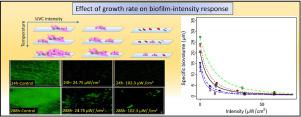Water Research ( IF 11.4 ) Pub Date : 2021-10-11 , DOI: 10.1016/j.watres.2021.117747 Hamed Torkzadeh 1 , Ezra L Cates 1

|
Biofilms can harbor a wide range of microorganisms, including opportunistic respiratory pathogens, and their establishment on engineered surfaces poses a risk to public health and industry. The emergence of compact germicidal ultraviolet light-emitting diodes (UV LEDs) may enable their incorporation into confined spaces to inhibit bacterial surface colonization on inaccessible surfaces, such as those in premise plumbing. Such applications necessitate knowledge of the quantitative response of biofilm growth rates to UV exposure on continuously irradiated surfaces. Herein, we performed experiments at varying flow cell temperatures in order to control baseline biofilm growth rates in the absence of UV; then, biofilm growth was compared under the same conditions but with simultaneous UVC irradiation. The inhibiting effect of UV irradiation on biofilm growth kinetics was diminished by more favorable growth conditions (higher temperature). Increasing the temperature by 10 °C resulted in an increase in biovolume by 193% under a UVC (254 nm) intensity of ∼60 µW/cm2. We further fitted an existing intensity response model to the biofilm growth data and analyzed the effects of temperature on model parameters, which were consistent with a hypothesized shielding effect arising from the deposition of extracellular colloidal materials. The shielding effect was found to result in breakthrough behavior of irradiated biofilms after 48 h, wherein accumulation of shielding substances eventually enabled biofilm establishment at even relatively high irradiation intensities (102.3 µW/cm2). With respect to applications of UVC irradiation for biofilm prevention, these results imply that surfaces more prone to bacterial colonization require disproportionately higher-intensity UVC irradiation for prevention of biofilm establishment, and continuous surface irradiation may be inadequate as a sole intervention for biofilm prevention in many scenarios.
中文翻译:

连续 UVC 照射下的生物膜生长:生长条件和生长时间对强度响应参数的定量影响
生物膜可以携带多种微生物,包括机会性呼吸道病原体,它们在工程表面上的形成对公共健康和工业构成风险。紧凑型杀菌紫外线发光二极管 (UV LED) 的出现可能使它们能够融入密闭空间,以抑制细菌在难以接近的表面上定植,例如室内管道中的表面。此类应用需要了解生物膜生长速率对持续照射表面的紫外线照射的定量响应。在这里,我们在不同的流动池温度下进行了实验,以便在没有紫外线的情况下控制基线生物膜生长速度;然后,在相同条件下但同时进行 UVC 照射比较生物膜的生长。更有利的生长条件(更高的温度)会减弱紫外线照射对生物膜生长动力学的抑制作用。在约 60 µW/cm 的 UVC (254 nm) 强度下,温度升高 10 °C 导致生物体积增加 193%2 . 我们进一步将现有的强度响应模型拟合到生物膜生长数据,并分析了温度对模型参数的影响,这与假设的细胞外胶体材料沉积产生的屏蔽效应一致。发现屏蔽效应会在 48 小时后导致辐照生物膜的突破行为,其中屏蔽物质的积累最终使生物膜在即使相对较高的辐照强度(102.3 µW/cm 2)。关于 UVC 辐射预防生物膜的应用,这些结果意味着更容易细菌定植的表面需要不成比例的更高强度的 UVC 辐射来预防生物膜的建立,并且在许多情况下,连续的表面辐射可能不足以作为生物膜预防的唯一干预措施。场景。











































 京公网安备 11010802027423号
京公网安备 11010802027423号